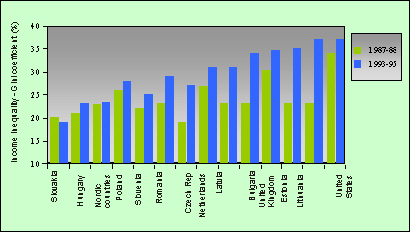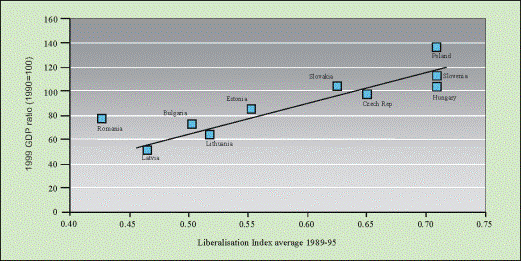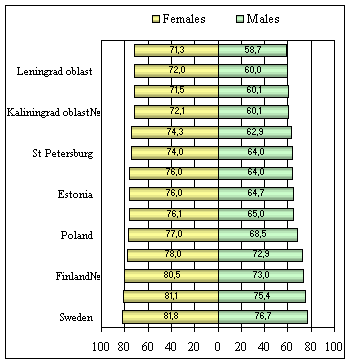1.2 Welfare
Economic welfare
The value of national production during the first decade of transition has generally decreased, with the exception of Poland.
|
Growing income inequality, 1987/88 to 1993/95
|

|
|
Source: Andersen, Reconnecting Europe, based on World Bank data for CEE countries
|
The situation is different in east German Länder, where economic decline in the early 90s was particularly strong. There, negative welfare consequences were largely avoided through growing transfer payments from other parts of Germany.
Economic trends in the BSR are difficult to predict. A dual economic development in the eastern BSR seems to be emerging, with strong growth in Poland, Estonia, Latvia and Lithuania, whereas Belarus and Russia are lagging behind.
In Estonia and Lithuania the lowest points were reached in 1994 and in Latvia 1993/95, after which GDP has increased at unprecedented rates.
Compared with the 1993 level, Poland had the fastest subsequent GDP growth in the whole BSR, close to 28% between 1993 and 1997. The second-fastest-growing economy was Mecklenburg-Vorpommern, with an increase of more than 24% during the same period. In contrast, growth in both Hamburg (8%) and Schleswig-Holstein (6.5%) has not been as significant.
In the Nordic countries during 1993-97, GDP increased by one-fifth in Finland and Norway, whereas growth in Denmark (14%) and Sweden (11%) was more modest. In the Baltic countries during the same period the economy of Estonia grew by 18% and Latvia by 15%. The deep plunge in the Lithuanian economy in 1993-94 has resulted in an overall GDP growth of only 3% during the period 1993-97. Growth in Belarus turned positive in 1996 and has gained momentum since.
Not as bad was the development of purchasing power of wages.
Not all population groups participated in the overall income improvement. Income distribution inequality increased, though not exceeding indices found in some western countries.
|
Early liberalisation and economic recovery
|

|
|
Source: World Development Report 1996; EBRD Transition Report, 1999 Update
|
Inequality indicators approached U.S. levels in Lithuania, Estonia. They remained somewhat lower (though also heavily increased) in Latvia. Least affected, within the BSR, remained Poland.
Regaining economic prosperity
The time required to turn to economic growth differed considerably between BSR transition countries, with Poland picking up first.
According to EBRD, early liberalisation was among the factors explaining best the speed of economic recovery:
Loss of knowledge advantages
Several transition countries found it difficult during the economic transformation process to provide opportunities for the highly technically skilled, to maintain and to update their skills. This led to loss of some of the region's best brains. For example, in Latvia, the number of people employed in full-time research positions fell by 77% (from 18,970 to 4,437) between 1990 and 19982 . In Belarus, idle industrial enterprises have retained most of their qualified staff. But economic decline made it difficult for these to maintain their advanced knowledge position in a world with increasing velocity of technological progress.
A widening gap between income levels of public and private sector has led to a brain drain from the public sector with potentially negative impacts on the quality of public services.
Life expectancy
Life expectancy indicates significant differences in the level of welfare between BSR countries. A male person born in 1996 in the Russian Republic of Karelia is expected to live nearly 20 years less than if he were born in Sweden, and a female almost ten years less. The difference between other transition countries and Nordic countries on the other is also significant.
Infant mortality rates show a similar pattern.
|
Life expectancy at birth (in years) in selected BSR countries and regions 1997
1
|

|
|
1996; Source: Nordregio based on The NEBI Yearbook 1999; except Belarus: MSA
|
According to the Russian State Statistics Committee, main reasons for the declining life expectancy in Russia are worsening economic conditions, the collapse of the health care system, and rising alcohol consumption. Development in the Baltic States has not been as dramatic, and life expectancy in e.g. Poland has even increased during the 1990s.

